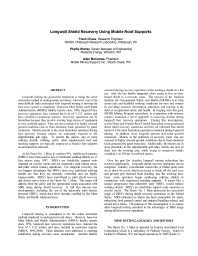Mining Publication: Longwall Shield Recovery Using Mobile Roof Supports
Original creation date: July 2007
Longwall mining has gained the reputation as being the safest extraction method in underground coal mines. However, one of the most difficult tasks associated with longwall mining is moving the face once a panel is completed. Based on Mine Safety and Health Administration (MSHA) fatality reports since 1996, longwall face recovery operations have claimed the lives of 5 U.S. miners and have resulted in numerous injuries. Recovery operations can be hazardous because they involve moving large pieces of equipment in very confined spaces. They are also conducted in highly stressed ground conditions due to front abutment loads generated by panel extraction. Shield removal is the most hazardous operation during face recovery because miners are constantly exposed to the unpredictable gob edge. To protect the miners, one or more walking shields, cribbing and/or other supplemental roof and standing supports are typically employed as breaker line supports as each shield is removed. At the Harris No. 1 Mine in southern WV, mobile roof supports (MRS's) have been used in lieu of traditional walking shields on 17 face moves since 1997. MRS's are shield-like support units mounted on crawler tracks and are commonly used during room-and-pillar retreat mining operations. For longwall recovery, the two biggest advantages that MRS's have over traditional walking shields are that they are remotely controlled and are highly maneuverable. MRS's have contributed to safer shield recovery and shorter move times at the Harris No. 1 Mine. This paper will address both the safety and the operational issues associated with MRS usage during shield recovery. It will also discuss new developments, including the use of the inherently safer battery powered MRS's, which have been recently certified by the Mine Safety and Health Administration.
Authors: FE Chase, P Worley, A McComas
Conference Paper - July 2007
NIOSHTIC2 Number: 20032434
In: Peng SS, Mark C, Finfinger GL, Tadolini SC, Khair AW, Heasley KA, Luo Y, eds., Proceedings of the 26th International Conference on Ground Control in Mining, July 31 - August 2, 2007, Morgantown, West Virginia, Morgantown, WV: West Virginia University, 2007; :173-179
See Also
- Bolt Load Changes During Initial Face Advance and Cross-Cut Breakthrough
- Effects of Water Sprays Used With a Machine-Mounted Scrubber on Face Methane Concentrations
- Evaluation of Support and Ground Response as Longwall Face Advances into and Widens Pre-Driven Recovery Room
- Guidelines for the Control and Monitoring of Methane Gas on Continuous Mining Operations
- Jet Fan Ventilation in Very Deep Cuts - A Preliminary Analysis
- Laboratory Testing To Quantify Dust Entrainment During Shield Advance
- Measurement of Airflow in a Simulated Underground Mine Environment Using an Ultrasonic Anemometer
- The NIOSH Shield Hydraulics Inspection and Evaluation of Leg Data (Shield) Computer Program
- Simulation of Methane Flows in Noncoal Mines
- Technology News 465 - Method for Predicting Methane Emissions on Extended Longwall Faces
- Page last reviewed: 9/21/2012
- Page last updated: 9/21/2012
- Content source: National Institute for Occupational Safety and Health, Mining Program


 ShareCompartir
ShareCompartir
